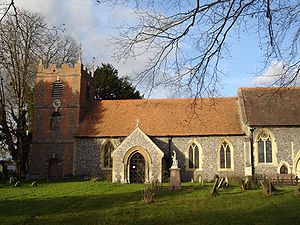
St Bartholomew's Church, Lower Basildon
Encyclopedia

_gravestone.jpg)
Church of England parish church
A parish church in the Church of England is the church which acts as the religious centre for the people within the smallest and most basic Church of England administrative region, known as a parish.-Parishes in England:...
of Basildon
Basildon, Berkshire
Basildon is a civil parish in the English county of Berkshire. It comprises the small villages of Upper Basildon and Lower Basildon, named for their respective heights above the River Thames...
in the English
England
England is a country that is part of the United Kingdom. It shares land borders with Scotland to the north and Wales to the west; the Irish Sea is to the north west, the Celtic Sea to the south west, with the North Sea to the east and the English Channel to the south separating it from continental...
county of Berkshire
Berkshire
Berkshire is a historic county in the South of England. It is also often referred to as the Royal County of Berkshire because of the presence of the royal residence of Windsor Castle in the county; this usage, which dates to the 19th century at least, was recognised by the Queen in 1957, and...
. It is located in the hamlet
Hamlet (place)
A hamlet is usually a rural settlement which is too small to be considered a village, though sometimes the word is used for a different sort of community. Historically, when a hamlet became large enough to justify building a church, it was then classified as a village...
of Lower Basildon
Lower Basildon
Lower Basildon is a small village in the civil parish of Basildon, near to Pangbourne, in the English county of Berkshire. It is the location of the parish church of St Bartholomew. The National Trust property, Basildon Park, is just above it....
and is now owned by the Churches Conservation Trust
Churches Conservation Trust
The Churches Conservation Trust, which was initially known as the Redundant Churches Fund, is a charity whose purpose is to protect historic churches at risk, those that have been made redundant by the Church of England. The Trust was established by the Pastoral Measure of 1968...
. The church has been designated by English Heritage
English Heritage
English Heritage . is an executive non-departmental public body of the British Government sponsored by the Department for Culture, Media and Sport...
as a Grade I listed building.
It was built in the late 13th century and is constructed of flint
Flint
Flint is a hard, sedimentary cryptocrystalline form of the mineral quartz, categorized as a variety of chert. It occurs chiefly as nodules and masses in sedimentary rocks, such as chalks and limestones. Inside the nodule, flint is usually dark grey, black, green, white, or brown in colour, and...
with stone dressings with an old tiled roof. The west tower of 1734 is of grey brick with red dressings and is in three stages. Below the louvred bell stage, containing four bells, is a clock on the south side. The church plan consists of nave
Nave
In Romanesque and Gothic Christian abbey, cathedral basilica and church architecture, the nave is the central approach to the high altar, the main body of the church. "Nave" was probably suggested by the keel shape of its vaulting...
, chancel
Chancel
In church architecture, the chancel is the space around the altar in the sanctuary at the liturgical east end of a traditional Christian church building...
, south porch and north aisle. The gabled porch is 19th century, as are the lean-to north aisle and chancel roof of 1876. In the chancel wall is a 14th century chest tomb, reused as a monument to Sir Francis Sykes who died in 1804. There is a 15th century font
Baptismal font
A baptismal font is an article of church furniture or a fixture used for the baptism of children and adults.-Aspersion and affusion fonts:...
.
The churchyard
Churchyard
A churchyard is a patch of land adjoining or surrounding a church which is usually owned by the relevant church or local parish itself. In the Scots language or Northern English language this can also be known as a kirkyard or kirkyaird....
is notable as the resting place of Jethro Tull
Jethro Tull (agriculturist)
Jethro Tull was an English agricultural pioneer who helped bring about the British Agricultural Revolution. He perfected a horse-drawn seed drill in 1701 that economically sowed the seeds in neat rows, and later a horse-drawn hoe...
, the 18th century agriculturalist, whose modern gravestone can be seen there. He died in 1741 but according to his gravestone he was buried on March 9, 1740. This apparent confusion is due to the burial date being an Old Style date.
See also
- List of churches preserved by the Churches Conservation Trust in South East England

